Periods are the worst, aren’t they? They make us tired, angry, bloated, prone to skin breakouts, insecure, jealous, heavy, and miserable––all that on top of painful period cramps.
You’ve probably found yourself, at some point or another, settled comfortably into your sofa, watching Netflix with your partner, and then suddenly, the hot ache of period pain spreads through your abdomen. You squirm in your seat, nostrils flared, silently seething at the person next to you for not washing
yesterday’s breakfast dishes.
And you wonder,
Why can’t they pick up some of the slack? How did I end up with such a lazy person anyway? How can I possibly climb the corporate ladder with a baby? Why do my jeans feel so tight today? Why does the laundry soap ad make me want to cry?Does that sound like you?
Let’s get something straight. You’re not alone. Many women, and by many we mean most, feel anywhere between a little bit and a lot like they’re losing their minds, before, during, and after their periods.
You’re probably thinking,
isn’t that most of the month? And if that’s the case––
am I resigned to feeling like crap most of my life?And wait––
am I actually losing my mind or is my tormented uterus twisting my reality?Why We Need To Stop & Listen To Period Pain
Although the biological process is the same for each woman, the timing of certain events varies from woman to woman. There is also a broad spectrum of emotional and psychological experience, or what some might call
suffering. Some women barely notice their periods approaching, while others can actually feel that carefully-selected egg making its way to the fallopian tube. That means your cycle is unique.
But what should feel like emotional relief for many women when things finally get flowing, instead brings forth cramps, heavy legs, back pain, anxiety, headache, or nausea. And whether we’re using pads, tampons, or the cup, we’re left to “soak up” the mess and get on with life, with little regard for this miraculous process that occurs within our bodies with each new moon.
We’re expected to push through and ignore symptoms that reflect what’s happening inside us. But those symptoms signal our body’s attempt to reestablish balance, and they’re the insight we need to hear and respect our body’s requirements at different times of the month.
Every woman, at one time or another, can admit to needing a good ‘ole fashioned, unabashed sob session to honor release on both fronts. Realistically, most of us just want period pain relief and the occasional lobotomy!
Clarissa Pinkola Estes, author of
Women Who Run With The Wolves, writes, “much of the modern women’s premenstrual crankiness is not just a physical syndrome but is equally attributable to her being thwarted in her need to take enough time away to revivify and renew herself” (1).
| Do you ever feel socially inadequate or a strong desire to be alone just before your period starts? This might explain why: Back in the day of nomadic tribal societies and some present-day traditional cultures, women are expected to isolate themselves from their communities during their flow. This ritual is meant to conserve energy required for menstruation and respond to a woman’s need for solitude. Some experts on the meta side of things suggest that women experience an innate tendency toward destruction in the premenstrual phase, coinciding with the darkening, waning full moon, and a depletion of their psychic energy. While that may seem a bit far out, it sheds some light on the rage, frustration, or sadness, the ”destructive emotions” many women exhibit just before their period begins. According to this perspective, isolation may actually support survival of the fittest! |
The Fascinating Feminine Cycle
How much do we really know about menstruation, a process that encompasses our experience as women and will dominate an average of 35-40 years of our lives? The biology of it, while a simple process, is more complex and connected to emotions and psychology than many of us are aware. It’s inextricably tied to nature, coinciding with the phases and duration of the lunar cycle.
It All Starts At Birth
Nature endows us with a finite number of eggs, about 1-2 million, within the first few weeks of life. Now that may sound like a lot, but by the time we reach puberty, only about 300K remain. And our bodies will only ovulate about 500 of them during our fertile years. By the time we reach menopause, we essentially run out of eggs (2).
There are four phases in the menstrual cycle, that combined, last about 28 days. Although the first day of a woman’s cycle begins with menstruation, we’ll first take a look at how our bodies arrive there. It all centers around the release of that one precious, naturally-selected egg, and the interaction of our hormones to regulate our cycle and give that egg the best chance at life.
First, We Choose The Best Of The Bunch
The follicular phase happens before the egg is released and lasts between 10 days and two weeks for most women. The pituitary gland in the brain increases its production of the follicle-stimulating hormone (FSH). Somewhere around 20 follicles, which are small fluid-filled sacs that contain an egg, develop in the ovaries. Our bodies intuitively select the best of what’s available, and one follicle continues to grow while the others degenerate. The ovaries produce more estrogen to prepare the uterus and stimulate the growth of luteinizing hormone (LS), which eventually surges and stimulates ovulation.
Next, We Release
The ovulatory phase lasts 16-32 hours, ending when the egg is released. The rise in LS causes it to erupt from the follicle. Then, it travels to the fallopian tube where it awaits fertilization. The egg is only fertile for up to 12 hours after its release, which is when pregnancy is most likely to occur.
Then, We Prepare The Nest
The luteal phase occurs after ovulation and lasts about 14 days if the egg isn’t fertilized. The ruptured follicle, from where the egg was released, forms a mass of cells called the corpus luteum. This gland increases progesterone levels, causing the uterine wall to become thick with nutrients and fluids to nourish a potential embryo. The body temperature rises, and mucus in the cervix thickens to prevent sperm and bacteria from entering the uterus. It’s all about protection and preservation now. High levels of progesterone and estrogen cause milk ducts in the breasts to dilate, resulting in swollen, tender breasts. If the egg isn’t fertilized, the corpus luteum degenerates and hormone levels decrease.
Finally, we bleed. Flow lasts anywhere from three to seven days.
That’s the biological process. But within it lies something very powerful: our individual experience.
Did You Know? - An egg cell is immobile
- We’re born with all the eggs we’ll ever have
- We lose about 1000 eggs each menstrual cycle
- Our egg cells are about 30x the size of a sperm cell
|
What Makes Periods Suck?
The short answer is PMS. It’s an acronym most women know intimately and raises the arm hair of many. About 90% of women experience Premenstrual Syndrome, which is characterized by a stifling cocktail of physical and emotional symptoms (3).
Emotional Symptoms: An impulse to destroy, seemingly unjustified rage, insecurity (overwhelming at times), and a tendency to be impulsive, jealous, irritated, nervous, frustrated, impatient, sad AF… the list goes on.
Physical Symptoms: Fatigue, anxiety, acne, cramps, bloating, insomnia, headaches, dizziness, nausea, constipation, diarrhea, backache, sore, heavy breasts. Cravings for giant slices of chocolate cake, followed by beer and pretzels. About the only favorable physical symptom is the random spike in sex drive. It seems your body knows its evolutionary purpose!
Cramps are one of the most common symptoms for premenstrual women. They can happen before, during, and after our period, and feel most intense about 24 hours after bleeding begins.
They typically last two or three days with either sharp or dull pain that extends to the lower back or legs. Cramps are more severe in women who started their period young, smoke cigarettes, or have a long, heavy flow.
Rather than accepting difficult emotions as destructive or physical discomfort as negative, PMS can prompt us to learn more about our bodies and our individual triggers and responses to events. They can also make us look more closely at how our diets may be worsening our symptoms. Keep reading to find out what helps period cramps.
The Impact of Stress
First, let’s look at the role stress plays in our periods. Chronic stress affects progesterone levels because your body has to work harder to produce the stress-regulating hormone cortisol. Too much stress can lead to hormone deficiency, which in turn, disrupts the body’s natural cycle.
Why does stress affect progesterone?
“Cortisol is made of the same “ingredients” as progesterone, and the body prioritizes defense from stress over just about everything, including fertility. Which makes sense when we consider the stressors in the natural world we evolved in (animal invasions, the search for food, drought and flood… not great times for babies). So the production of the stress hormone literally robs the body of progesterone, by design.” (4).
Tips for Relieving Stress & Lessening Period Pain
- Get sufficient rest
- Reduce caffeine & alcohol consumption
- Meditate every day, in a way that works for you
- Exercise every day and work up a good, detoxifying sweat
- Practice yoga, Tai Chi, Qigong, or another form of mindful movement
| What Other People ThinkSocial attitudes and the popular discourse surrounding menstruation often inhibit our willingness to open up about it, accept the discomfort of it, and most critically, impact our individual experience with it. Even the euphemisms we attach to it reflect the nature of our relationship with it: the rag, the curse, the moon cycle, the storm, Aunt Flow. (Check out Buzzfeed’s satirical take on why it’s called a period). Our response to these opinions and circumstances beyond our control points to how well we embrace this natural biological process. |
What Helps Period Cramps?
The Right Food Makes Everything Better
We are what we eat, literally. Our bodies are composed of food, and so we become whatever we choose to feed ourselves. Our bodies can’t recognize cheese doodles, so it considers such food foreign, toxic waste. But, persistent by nature, the body tries to make some sense of those cheese doodles. So, before we can eliminate them, they wreak some havoc on the body and disrupt how our hormones function. That explains why we also
act what we eat. If we’re to achieve a physiological balance, then we need to feed ourselves the right stuff.
What we eat throughout our cycle can worsen or lessen PMS symptoms. You might already know that all the foods doctors and nutritionists recommend for counteracting PMS are NOT what you’re interested in eating. They’re not the sugars and carbs that your body craves when progesterone is low and estrogen is high. Now that we know stress depletes progesterone, it makes sense that we crave all the wrong foods before our periods.
Cravings usually indicate that your body is deficient in some vitamins and minerals or that it requires more of certain types because of the changes in hormone levels at different times during your cycle. When you start giving your body what it actually needs, rather than what it wants, it becomes more balanced and less belligerent.
Foods That Help Period Pain Relief:
- Fish & shellfish
- Nuts, seeds & legumes
- Dark leafy greens like spinach & kale
- Foods rich in iron, B vitamins, omega-3, and zinc
| What’s The Moon Got To Do With It?According to some alternative disciplines, synchronization with the moon’s phases indicates health because it means a woman is connected to and in harmony with nature. The belief is that ovulation should occur with the full moon, and flow should coincide with the dark moon. |
Essential Supplements For Menstrual Pain Relief
What helps cramps besides Tylenol or Advil? Taking the right vitamin and mineral supplements can relieve period pain naturally and easily. Check with a nutritionist or doctor before taking a supplement to determine what dose is right for you.
Keep reading to discover what vitamins and minerals help ease period pain and reduce PMS symptoms. Nutrition Smart has a huge savings event happening in May, with discounts on the following vitamin and mineral supplements. Visit one of our
seven locations before inventory runs out.
VITAMIN B-6
Vitamin B-6 if vital for the development of the corpus luteum. You might remember, that’s the gland that increases progesterone levels and regulates a healthy cycle. Low progesterone can cause headaches, anxiety, depression, and weight gain. Sound familiar?
B-6 also has an important role in liver function, which keeps hormone levels balanced, and lessens mood swings and fatigue.
| FOODS RICH IN VITAMIN B-6 |
| ● Spinach
● Bananas
● Chickpeas
● Macadamia nuts
● Sunflower seeds | ● Eggs
● Trout
● Tuna
● Potatoes
● Lean red meat |
Taking a vitamin supplement is often necessary to ensure your body has optimal levels of B-vitamins. An excellent B-complex supplement offers a pure, concentrated source of B-vitamins, including B6.
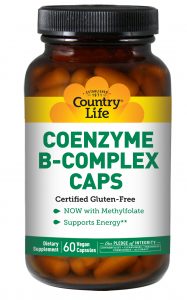
Take advantage of big savings on
Country Life Coenzyme B-Complex, 60 count, available in May for only $11.99.OMEGA 3
The cells of the endometrium create large amounts of a chemical called prostaglandins just before menstruation begins. When the endometrium is shed, the prostaglandins break down and constrict the blood vessels in the uterus, causing cramping and pain. Omega 3 fatty acids reduce prostaglandins, helping to control inflammation and lessen the pain of period cramps and headaches.
| FOODS RICH IN OMEGA 3 |
| ● Plant oils such as flaxseed, soybean & canola
● Nuts & seeds, such as flaxseed, chia seeds & walnuts
● Fortified foods, such as certain brands of eggs, yogurt, juice, milk & soy drinks
● Fish & seafood, especially cold water fish like salmon, mackerel, tuna, herring & sardines |
While fish is one of the best sources of omega 3, getting the right levels to manage prostaglandins means eating a lot of it. Omega 3 fatty acids are best derived from a high-quality supplement made with naturally-sourced ingredients.
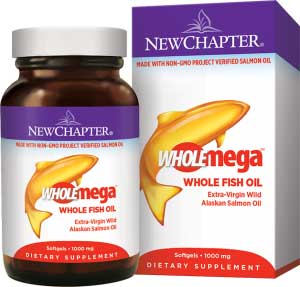 New Chapter
New Chapter makes a certified sustainable, gluten-free fish oil to help battle period pain. Save big on their
Wholemega Whole Fish Oil 60 softgels, for $17.99, or get the most value when you buy 120 softgels for $32.99. Sale price available in May only.
ZINC
Zinc is a powerful anti-inflammatory and antioxidant that contributes to the production of estrogen and progesterone and stimulates blood flow. It also has a role in fertility. Include zinc-rich foods in your diet to help treat and prevent period cramps and associated pain. The best dietary sources of zinc come from animal foods.
| FOODS RICH IN ZINC |
| ● Eggs
● Beef
● Pork
● Chicken
● Shellfish
● Dairy, particularly yogurt | ● Legumes
● Chickpeas
● Cashew nuts
● Whole grains
● Kidney beans
● Pumpkin seeds |
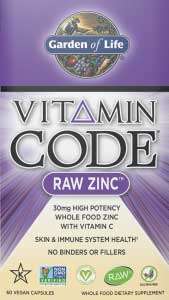
The zinc found in plant foods is tough to absorb so vegans may choose to take a supplement to avoid zinc deficiency.
Garden of Life Vitamin Code Zinc provides a pure source of zinc. Get
60 capsules for $9.79 in May only.
MAGNESIUM
Magnesium is an essential mineral found in the bones and muscles. It supports movement and regulates the nervous system. Remember the battle between progesterone and cortisol in the body’s stress response? A diet rich in magnesium can actually replenish the progesterone lost to cortisol (5). Magnesium relaxes the muscles and eases discomfort in the stomach. It balances mood and eases period cramps.
| FOODS RICH IN MAGNESIUM |
| ● Kale
● Salmon
● Spinach
● Mackerel
● Brown rice
● Swiss chard
● Pumpkin seeds | ● Halibut
● Quinoa
● Avocado
● Almonds
● Cashews
● Black beans
● Dark chocolate |
If you can’t get all of these foods in your diet, a supplement is the way to go to ensure you’re getting an adequate dose of this vital mineral. At Nutrition Smart, we engineer a magnesium glycinate that is easily absorbed by the body and gentle on the stomach. Choose your best value and boost your magnesium levels before your next period.
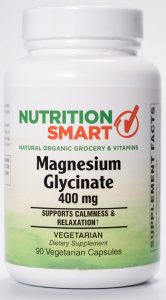 Nutrition Smart Brand Magnesium Glycinate 90 capsules $9.99 or 180 capsules for $18.99. On sale in May only.
Nutrition Smart Brand Magnesium Glycinate 90 capsules $9.99 or 180 capsules for $18.99. On sale in May only.GAMMA LINOLENIC ACID (GLA)
GLA is an omega 6 essential fatty acid instrumental in reducing inflammation. It works much like omega 3, to bring period pain relief and alleviate other physical symptoms.
Primrose oil is widely touted as one of the best natural sources of omega 6 for improving symptoms of PMS. And because it’s plant-based, vegans can reap the benefits too.
Get
Solgar Evening Primrose Oil 1300mg 60 softgels for $6.80, a limited-time low price in May only.
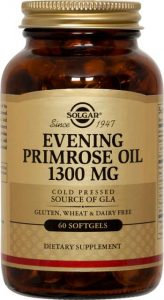
| FOODS RICH IN GAMMA LINOLENIC ACID (OMEGA 6) |
| ● Acai berries
● Flaxseeds & flaxseed meal
● Nuts, including pine nuts & pistachios
● Flaxseed, hemp seed & grapeseed oils
● Seeds, such as hemp, pumpkin & raw sunflower
● Borage oil, evening primrose oil, black currant seed oil |
IRON
Non-heme iron foods, or iron from plant-based sources or supplements, can reduce PMS symptoms. Researchers at the University of Massachusetts conducted a 10-year study involving 3000 women on the association between iron consumption and PMS. They found that women who supplemented with more than 20 mg of iron every day were 35 percent less likely to experience PMS than women who didn’t take iron supplements (6).
| FOODS RICH IN IRON |
| ● Clams
● Oysters
● Beef liver
● Liverwurst
● Chicken liver | ● Tofu
● Cooked lentils
● Cooked spinach
● Cooked soybeans
● Blackstrap molasses |
Getting enough dietary sources of iron is a tall order. Iron deficiency is common in women and many doctors recommend taking an iron supplement to boost production of oxygen-transporting red blood cells. Here’s what we recommend:
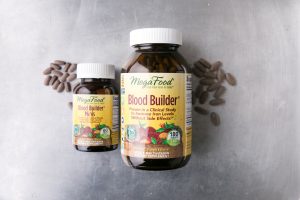 Megafood Blood Builder, available at the following prices in May only: 30 tablets ($12.99), 60 tablets ($19.99), 90 tablets ($23.99), 180 tablets ($38.99)
Megafood Blood Builder, available at the following prices in May only: 30 tablets ($12.99), 60 tablets ($19.99), 90 tablets ($23.99), 180 tablets ($38.99)Or, try
Megafood Blood Builder Minis, 60 tablets for $12.99 in May only.Get Stronger & Wiser Everyday
A woman’s relationship with her body within the context of her period can determine how easy or difficult her premenstrual experience is. The less we resist symptoms, the greater our capacity to acknowledge and treat them in a manner that honors and respects our bodies.
Get enough rest. Give into the need for solitude and recovery time. Make exercise a priority. Reduce alcohol consumption.
One of the most critical elements in alleviating symptoms of PMS? Choosing the right foods, and it applies to every woman. We could all stand to include more nutrient-rich foods in our diet, especially if they take the edge off what is an otherwise turbulent time.
We’ve discovered exactly what happens during the menstrual cycle and why PMS occurs.
We’ve also become aware of how certain foods and supplements can help.
Now, we want to know as much as we can about eating for overall health and wellness.
You know your period doesn’t have to suck. It just takes a bit of foresight, the will to make a few tweaks in your daily life and eating habits, and the right knowledge. Get free, easily-digestible chunks of great info from nutrition experts regularly sent to you by
joining our community.Have you tried a particular supplement and want to keep reaping the benefits? Get 10% off when you
Sign Up” data-wplink-url-error=”true”>join our Loyalty Program now.References - Estés, Clarissa Pinkola. (1992). Women who run with the wolves: myths and stories of the wild woman archetype. New York :Ballantine Books.
- https://www.webmd.com/menopause/qa/how-many-eggs-does-a-woman-have
- https://www.womenshealth.gov/menstrual-cycle/premenstrual-syndrome
- https://www.kindara.com/blog/the-battle-of-cortisol-and-progesterone
- Briden, L. (2015). Period repair manual: Natural treatment for better hormones and better periods.
- https://www.umass.edu/sphhs/news-events/bertone-johnson-and-team-find-women%E2%80%99s-iron-intake-may-help-protect-against-pms
 Take advantage of big savings on Country Life Coenzyme B-Complex, 60 count, available in May for only $11.99.
Take advantage of big savings on Country Life Coenzyme B-Complex, 60 count, available in May for only $11.99. New Chapter makes a certified sustainable, gluten-free fish oil to help battle period pain. Save big on their Wholemega Whole Fish Oil 60 softgels, for $17.99, or get the most value when you buy 120 softgels for $32.99. Sale price available in May only.
New Chapter makes a certified sustainable, gluten-free fish oil to help battle period pain. Save big on their Wholemega Whole Fish Oil 60 softgels, for $17.99, or get the most value when you buy 120 softgels for $32.99. Sale price available in May only. The zinc found in plant foods is tough to absorb so vegans may choose to take a supplement to avoid zinc deficiency. Garden of Life Vitamin Code Zinc provides a pure source of zinc. Get 60 capsules for $9.79 in May only.
The zinc found in plant foods is tough to absorb so vegans may choose to take a supplement to avoid zinc deficiency. Garden of Life Vitamin Code Zinc provides a pure source of zinc. Get 60 capsules for $9.79 in May only. Nutrition Smart Brand Magnesium Glycinate 90 capsules $9.99 or 180 capsules for $18.99. On sale in May only.
Nutrition Smart Brand Magnesium Glycinate 90 capsules $9.99 or 180 capsules for $18.99. On sale in May only.
 Megafood Blood Builder, available at the following prices in May only: 30 tablets ($12.99), 60 tablets ($19.99), 90 tablets ($23.99), 180 tablets ($38.99)Or, try Megafood Blood Builder Minis, 60 tablets for $12.99 in May only.
Megafood Blood Builder, available at the following prices in May only: 30 tablets ($12.99), 60 tablets ($19.99), 90 tablets ($23.99), 180 tablets ($38.99)Or, try Megafood Blood Builder Minis, 60 tablets for $12.99 in May only. Take advantage of big savings on Country Life Coenzyme B-Complex, 60 count, available in May for only $11.99.
Take advantage of big savings on Country Life Coenzyme B-Complex, 60 count, available in May for only $11.99. New Chapter makes a certified sustainable, gluten-free fish oil to help battle period pain. Save big on their Wholemega Whole Fish Oil 60 softgels, for $17.99, or get the most value when you buy 120 softgels for $32.99. Sale price available in May only.
New Chapter makes a certified sustainable, gluten-free fish oil to help battle period pain. Save big on their Wholemega Whole Fish Oil 60 softgels, for $17.99, or get the most value when you buy 120 softgels for $32.99. Sale price available in May only. The zinc found in plant foods is tough to absorb so vegans may choose to take a supplement to avoid zinc deficiency. Garden of Life Vitamin Code Zinc provides a pure source of zinc. Get 60 capsules for $9.79 in May only.
The zinc found in plant foods is tough to absorb so vegans may choose to take a supplement to avoid zinc deficiency. Garden of Life Vitamin Code Zinc provides a pure source of zinc. Get 60 capsules for $9.79 in May only. Nutrition Smart Brand Magnesium Glycinate 90 capsules $9.99 or 180 capsules for $18.99. On sale in May only.
Nutrition Smart Brand Magnesium Glycinate 90 capsules $9.99 or 180 capsules for $18.99. On sale in May only.
 Megafood Blood Builder, available at the following prices in May only: 30 tablets ($12.99), 60 tablets ($19.99), 90 tablets ($23.99), 180 tablets ($38.99)Or, try Megafood Blood Builder Minis, 60 tablets for $12.99 in May only.
Megafood Blood Builder, available at the following prices in May only: 30 tablets ($12.99), 60 tablets ($19.99), 90 tablets ($23.99), 180 tablets ($38.99)Or, try Megafood Blood Builder Minis, 60 tablets for $12.99 in May only.
